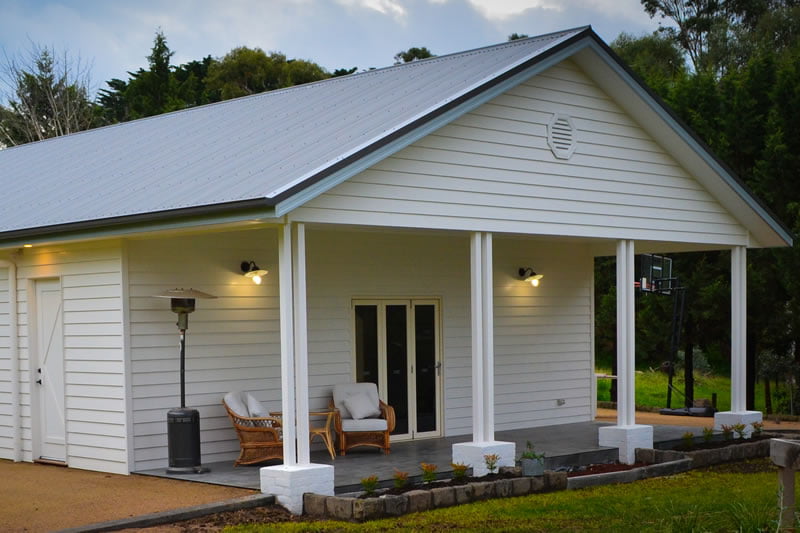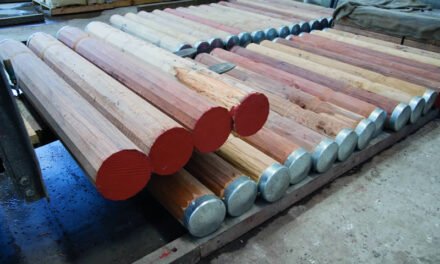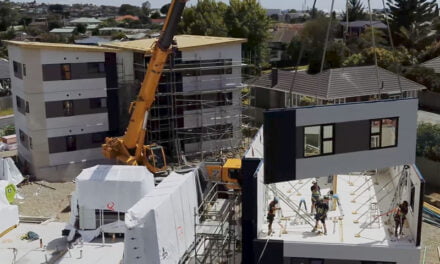For healthy building, fire zones and flood areas, Magnum Board is a one-stop solution.
Three of the key requirements owners and builders have for their materials in Australia are ‘copes with fire’, ‘copes with flood’ and ‘healthy for occupants’. We’ve become increasingly good at the first one, but when it comes to family homes and small commercial and public builds, we’re still pretty mediocre at the other two.
Which is why McCormack Hardwood Sales is so excited about Magnum Board. It’s non-combustible, retains its strength and dries out fully after being wet, and naturally stops the growth of mould, insect attack and build-up of VOCs within the home.
“It’s a magnesium oxide board – MgO,” says McCormack’s Glenn Lawrenson. “So it’s suitable up to BAL-FZ. You can use it as weatherboards or as flooring, particularly in wet areas. In New Zealand and the US where it’s been available for a long time, it’s also used as internal lining as part of a whole system for a house that ‘breathes’. The board is so strong and versatile, and also very safe for both the installer and the people who live or work in the building.”
Magnum Board isn’t the first MgO board on the market, but unlike most others it is 100% cement free – a key component in McCormack’s decision to stock this product after several years trialling MgO products.
“When there’s cement in a product, it draws and hold moisture, and that weakens it,” says Lawrenson. “Magnum Board doesn’t hold moisture. So if it does get wet, it doesn’t hold the water, it just dries off.
“In Florida, they use a lot of this product because they get a lot of floods. They just sweep the water out and the walls are fine. It’s not like plaster, where you have to rip it all out after a flood because it’s destroyed.”
The lack of cement also removes the risks that come with silica in cutting traditional cement sheeting. Magnum Board is cut and fixed just as standard sheeting, the installer just needs a dust mask, as for timber.
Tried and tested
Magnum Board was developed by American-based Magnum Board Products (MBP). “The guys who run the company are basically two engineers,” says Lawrenson. “And they developed both the product and the process and machinery to manufacture it.”
With China a leading supplier of magnesium and well-positioned for delivery to international markets, MBP moved the machinery and manufacture there. “It’s manufactured there under license out of the US,” says Lawrenson. “So all the quality control is done through MBP.”
This includes multiple inspections, from raw material to in-process and final product. MBP’s own lab carries out regular inspection testing and the product also has a long list of independently tested certifications, including flame spread, fire rating, durability, VOC and the UL 2000-hour Freeze Thaw test, simulating 20 years of wear and tear in all climactic conditions. Manufacturing records are held for seven years as part of MBP’s quality control process.
“It’s used around the world and there have been no product-related failures since it entered the market in 2003,” Lawrenson says. “In the end it was an easy choice for us to go with Magnum Board, because we can use it in exactly the same way as a lot of existing products, but with better results. It’s stronger and more dimensionally stable as well as being recyclable and carbon negative over its lifespan.
“Right now we’re mostly using it as wet area flooring and weatherboards, but we’ve been looking at how they’re using it in New Zealand, where it’s a core part of a new model called ForeverBreathe.”
Breathe easy
Health Based Building in New Zealand uses Magnum Board as part of its ForeverBreathe specification, which was developed in response to ongoing issues with leaky homes, mould and VOC build-up in New Zealand’s highly insulated homes.
“Robin Curtis of Health Based Building, encountered MBP when he was working in the States and when he returned to NZ, he utilised Magnum Board as part of their full house build system,” says Lawrenson. “It solves their main problems: mould can’t grow on it and, with their system, the whole house breathes, delivering good air quality.”
The system includes Magnum Board as wall lining as well as weatherboards, with a permeable paint and sheep wool insulation that doesn’t hold moisture.
“You don’t get the build up of VOC or CO2 gasses, and the walls stay dry,” Lawrenson says. “So while the Magnum Board price point is a little bit above plaster board, you make that back very quickly, because when you turn on the heater, you’re not having to spend an hour drying out the walls before you start heating the house.
“It’s a small initial difference and a big lifetime saving. We need to stop asking ourselves ‘How much does this house cost to build?’ and start asking ‘How much does this house cost to run?’”
McCormacks is already fielding enquiries about similar systems in Australia.
For more information, visit www.healthbasedbuilding.com.au
Image: Magnum Board comes standard cut into weatherboards that don’t require specialist fixings and are ready to take a coating.












